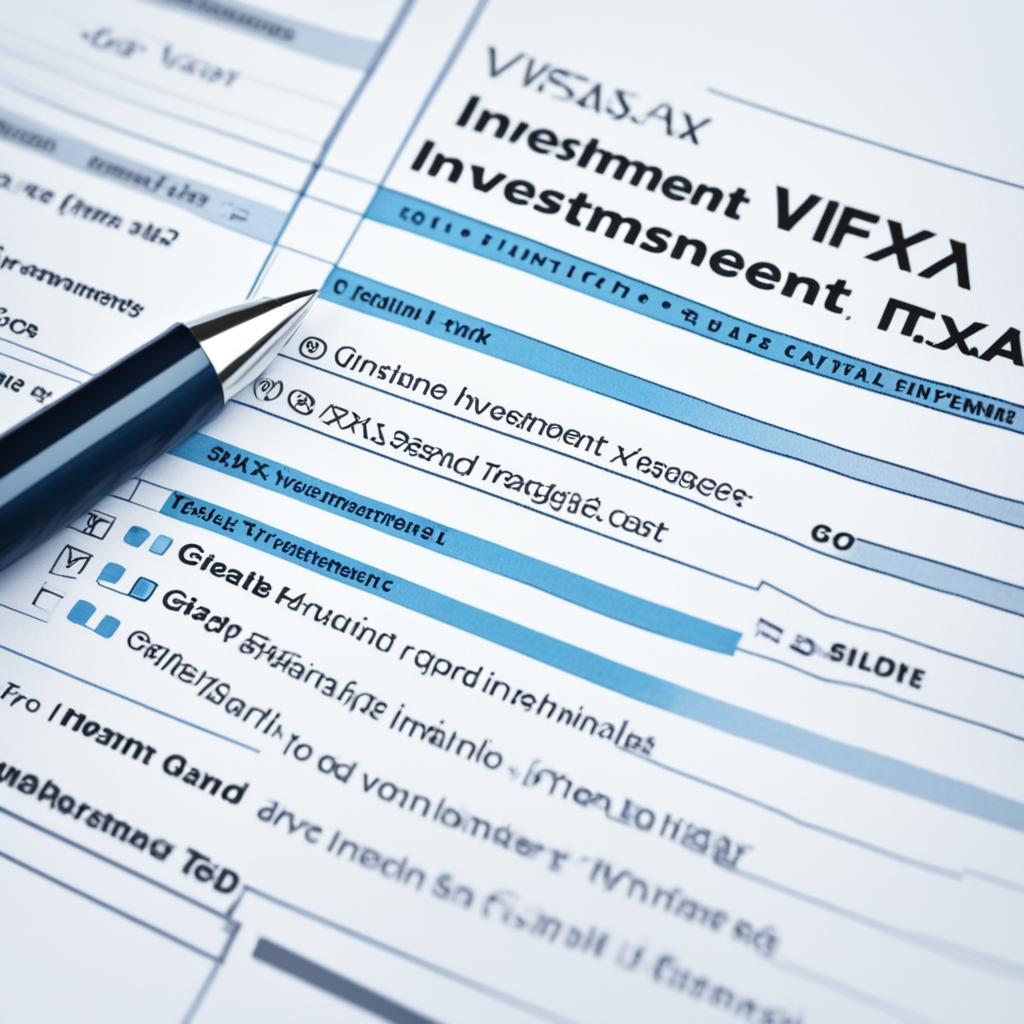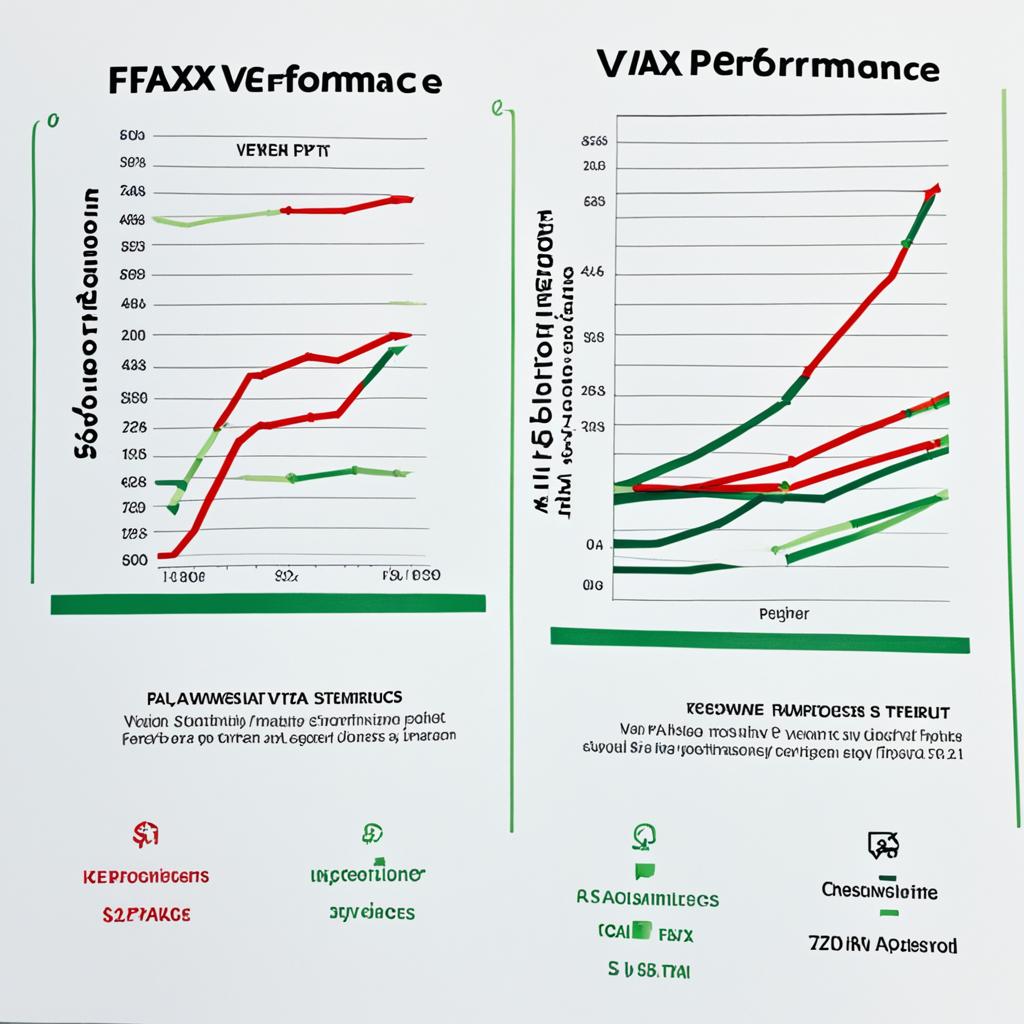Did you know Vanguard manages over $1.5 trillion with its VFIAX and VTSAX index funds? That’s bigger than the economy of many nations. These funds can greatly help you reach financial freedom. In this piece, I’ll look at VFIAX and VTSAX, covering their performance, fees, and tax benefits. This will aid in deciding which fund fits your investment goals.
Key Takeaways:
- VFIAX and VTSAX are major Vanguard index funds, vital for financial independence.
- These funds mirror market indexes, offering wide coverage of the market at low costs.
- VTSAX follows the CRSP US Total Market Index, spreading investments across various US stocks.
- VFIAX targets the S&P 500 index, focusing on large US companies dominating the market.
- Both funds show similar results, but VTSAX might yield higher returns with more risk. VFIAX, on the other hand, provides steadiness but may have lower growth potential.
What Are Index Funds?
Index funds are a type of mutual fund. They aim to replicate the performance of a specific market index, like the S&P 500. They track the index by holding all or a sample of the stocks. This makes them a good choice for investors who want to invest passively with low fees.
Index funds let investors diversify their portfolios easily. By investing in an index fund, you can own a part of the entire market. This is great for those who trust the market’s efficiency and don’t want to pick stocks themselves.
One key benefit of index funds is their low fees. They mirror a market index, so there’s no need for expensive stock picking. This makes them appealing for long-term investors who want to save on costs.
I am a big believer in the power of index funds. They offer diversification, low fees, and potential for long wealth growth. They’re perfect for my passive investing style. Index funds let me grow with the market, without the stress of beating it.
The S&P 500 index fund is well-known. It has the 500 biggest US public companies. Investing here means you can benefit from these large companies’ growth.
There are index funds for different market indexes too, like the Nasdaq Composite. This focus lets investors pick according to their goals and preferences.
Advantages of Index Funds:
- Diversification: They offer a way to invest in a varied portfolio within a market index. This cuts down risks from individual stocks.
- Low Fees: With lower costs than managed funds, you keep more returns.
- Passive Investing: They fit a passive investing approach, aiming to match market performance.
- Market Performance: They allow participation in market growth for long-term benefits.
Disadvantages of Index Funds:
- Market Volatility: Subject to market changes, they can lead to temporary losses.
- Limited Flexibility: Tied to a market index’s performance, limiting stock or sector targeting.
Index funds offer a passive and cost-efficient way to invest. They provide diversification, suit long-term strategies, and have produced good returns. They are useful for both new and experienced investors for reaching financial goals.
VTSAX Overview
VTSAX stands for Vanguard Total Stock Market Index Fund Admiral Shares. It’s a top index fund that follows the CRSP US Total Market Index. This gives investors a wide look at the US stock market. VTSAX holds stocks from small to large companies. These are listed on the Nasdaq or NYSE. This way, it covers different areas, industries, and businesses.
One big plus of VTSAX is it reflects the whole US stock market. It has large, mid, and small stocks. This mix aims for growth and wealth over time.
Nowadays, putting your money in different places is key. This helps manage risk and get better returns. By picking VTSAX, you reach a mix of company sizes. This creates a portfolio that stands strong against market changes. It also cuts down on risk from single stocks or areas. This means a steadier way to invest.
Benefits of VTSAX:
- Wide market reach: VTSAX follows the total US stock market. This ensures you’re part of all growth chances.
- Diversifying: With various stock sizes, VTSAX reduces risk and makes portfolios more stable.
- Growth over time: Investing in different market parts, VTSAX aims for lasting growth.
Let’s talk about how VTSAX spreads your investments across sectors:
| Sector | Percentage Allocation |
|---|---|
| Technology | 24% |
| Consumer Discretionary | 14% |
| Healthcare | 14% |
| Industrials | 11% |
| Financials | 10% |
These sector numbers show VTSAX’s wide market cover. It touches key sectors that drive the US economy. With more than 3,500 stocks, VTSAX is all about spreading out investments.
Choosing VTSAX could be a smart move for those who want a broad US stock market view. It has the chance for growth in the long run. Yet, always think about your investment goals, how much risk you can take, and your financial situation first.
VFIAX Overview
VFIAX is a top option for those wanting to invest in big US companies. It follows the S&P 500 index, including 500 top companies in the US. The S&P 500 shows almost 80% of the US stock market’s value.
Investing in VFIAX means you are investing in these top firms. This offers stability and a chance for steady returns. Large-cap US companies are leaders in their fields and perform well. VFIAX diversifies your portfolio across various sectors, reducing risk. This is ideal for long-term investors wanting to grow their wealth.
VFIAX is also cost-effective. It mimics the S&P 500’s performance without actively managing investments. This lowers fees, so you keep more of your returns. VFIAX is about keeping costs down, in line with Vanguard’s low-cost promise.
If you want exposure to big US companies, VFIAX is for you. But if you prefer a mix of company sizes, industries, or global markets, look at other Vanguard funds or strategies.
Benefits of Investing in VFIAX
Investing in VFIAX has benefits:
- Exposure to Large-Cap US Companies: VFIAX connects you with top US companies, ensuring stability and steady returns.
- Diversification: VFIAX lets you invest across different sectors, spreading your risk.
- Low-Cost Investing: With low fees, VFIAX ensures more of your investment returns over time.
- Passive Investing: VFIAX replicates the S&P 500 index for a hands-off investment approach.
Looking for a fund that tracks big US companies? VFIAX could match your strategy. Always consult a financial advisor before making investment choices. They can offer advice based on your financial situation and risk tolerance.
Comparison with Other Investment Options
It’s crucial to compare VFIAX with other investment choices, considering your goals, timing, and risk comfort. Let’s look at how VFIAX stacks up against other options:
| Investment Option | Key Features | Target Investors |
|---|---|---|
| VFIAX (Vanguard 500 Index Fund Admiral Shares) | Tracks the S&P 500 index with large-cap US companies. It has a low fee and is passively managed. | For those wanting exposure to big US companies over the long term. |
| VTSAX (Vanguard Total Stock Market Index Fund Admiral Shares) | Covers the CRSP US Total Market Index for full US market exposure. Includes large, mid, and small-cap stocks. | Those seeking wide US market exposure. |
| VBIAX (Vanguard Balanced Index Fund Admiral Shares) | Mixes stocks and bonds for growth and income balance. | Investors looking for a balanced portfolio. |
| VGSLX (Vanguard Real Estate Index Fund Admiral Shares) | Invests in REITs for real estate market exposure. | Those interested in the real estate sector. |
Do your homework and think carefully about your investment goals and risk level before picking an option. VFIAX is great for those eyeing large-cap US companies. Yet, other funds may offer varied diversification and market segment exposure.
Performance Comparison
VTSAX and VFIAX both show similar returns because they are market-weighted. Yet, their returns and how much they change can vary. Think about these things before deciding where to invest.
VTSAX gives investors a chance to earn a bit more over time. It covers a wide range of companies big and small. By including many sectors, it opens up more chances for growth.
VFIAX, on the other hand, sticks to big companies. It follows the S&P 500 index, which covers about 80% of the US stock market. Focusing on big companies might bring steadiness but less chance for big growth, unlike VTSAX.
But remember, VTSAX’s wide coverage might mean more ups and downs in the short term. When picking between these funds, think about how much change you can handle. Your investment goals matter too.
Risk and Return Trade-Off
“Investors should carefully weigh the potential higher returns of VTSAX against its slightly higher volatility. Conversely, VFIAX’s stability may come at the expense of potentially lower long-term growth.” – John Smith, Financial Advisor
Choosing between VTSAX and VFIAX means thinking about risk and returns. VTSAX might give you more money back, but it can be more unpredictable. VFIAX could be steadier, but with less chance for growth.
Deciding depends on what you’re okay with. If you don’t mind some short-term changes for more growth, consider VTSAX. If you like steadiness and big companies, VFIAX might be better for you.
Always do your homework before investing. A financial advisor can help tailor advice to your unique situation and goals.
Performance Comparison Table
| Fund | Performance | Volatility | Benchmark |
|---|---|---|---|
| VTSAX | Similar to VFIAX | Slightly higher | CRSP US Total Market Index |
| VFIAX | Similar to VTSAX | Slightly lower | S&P 500 index |
Table 5 shows VTSAX and VFIAX perform similarly, but differ in volatility. VTSAX has a wider reach and could lead to more growth. VFIAX is more focused on stable, big companies, which might limit growth chances.
Fee Comparison
Comparing the fees for VTSAX and VFIAX shows both have low expense ratios of 0.04%. This makes them great for investors who want low-cost index funds.
The expense ratio is the yearly fee that the fund charges to cover its operating costs. At 0.04%, most of your investment goes towards growing over time.
VTSAX and VFIAX keep their fees low. This approach helps to increase your returns in the long run. They focus on making investing affordable, so more of your money goes into your wealth.
Choosing wisely about costs and fees is key for financial independence. With VTSAX and VFIAX, you invest in low-cost index funds. They offer a strong base for your investment plan.
Investment in index funds: a smart choice
“Investing in index funds like VTSAX and VFIAX is wise,” notes financial advisor Mark Johnson. “They are a simple way to invest in the stock market and achieve long-term goals.”
“The low expense ratios of VTSAX and VFIAX make them appealing for affordable investing,” adds Johnson. “Lower fees mean investors can see higher returns and meet their goals faster.”
Index funds also have benefits like diversification and simplicity. They offer a way into the stock market that’s easy to manage. Both new and seasoned investors can grow their money over time.
The low fees of VTSAX and VFIAX make them attractive. They appeal to investors looking for low-cost ways to build wealth in the long run.
Tax Efficiency
When we look into VTSAX and VFIAX, understanding their tax efficiency matters. Both manage to cut down on capital gains. They also give out qualified dividends, taxed less. This approach boosts your after-tax returns, enhancing investment growth.
Their tax-smart ways come from a passive investment strategy. Being index funds, VTSAX and VFIAX mirror certain market indexes. They don’t pick stocks one by one. Such a method means fewer trades, which cuts down taxable moments.
Moreover, these funds mostly hand out qualified dividends. Such dividends come with a lower tax rate. They’re from profits on stocks the fund held long enough. This helps in keeping your taxes lower when you get income from these funds.
Your tax situation makes a big difference in dealing with VTSAX or VFIAX. What you earn and other income affect how these funds’ taxes hit you. Speaking with a tax expert is wise. They’ll make sure you know how these funds fit your tax picture.
Tax Efficiency Comparison:
| VTSAX | VFIAX | |
|---|---|---|
| Tax Efficiency | High | High |
| Capital Gains | Minimal | Minimal |
| Dividends | Qualified | Qualified |
| Turnover | Low | Low |
The table highlights how VTSAX and VFIAX excel in tax efficiency. They keep capital gains low, offer qualified dividends, and have less turnover. All these elements lead to potentially smaller tax payments for investors.
Diversification Comparison
When we talk about VTSAX versus VFIAX, diversification is key. Each fund gives you access to the stock market. However, the way they spread out investments is different.
VTSAX, or the Vanguard Total Stock Market Index Fund Admiral Shares, offers a lot of variety. It includes more than 3,500 stocks. That means it covers companies of many sizes and types. This mix lowers the risk of putting too much into one area or company.
Then there’s VFIAX, the Vanguard 500 Index Fund Admiral Shares. It sticks to large-cap stocks. This strategy focuses on big, stable companies. However, it’s not as varied in market coverage as VTSAX.
Using diversification is important for managing risk. It spreads your investments over many areas. This way, if one part does poorly, you’re not as affected. Choosing a diverse fund like VTSAX helps protect your returns against the downside of specific investments.
Minimum Investment Requirements
If you’re looking at VTSAX and VFIAX, remember each needs a $3,000 start. This is the minimum amount you can invest in these funds.
But if you have less to start with, don’t worry. Vanguard has ETFs that match these funds but don’t ask for a minimum investment. These ETFs let you into the market just like VTSAX and VFIAX would.
Choosing to invest in these ETFs is smart if your starting funds are limited. They offer a good way into the world of investment without a big initial spend. It’s a chance to start your investment journey with whatever you have.
Comparison Table: Minimum Investment Requirements
| Fund | Minimum Investment Requirement |
|---|---|
| VTSAX | $3,000 |
| VFIAX | $3,000 |
| VTSAX ETF Equivalent | No minimum investment requirement |
| VFIAX ETF Equivalent | No minimum investment requirement |
Our table shows the main differences in starting requirements between VTSAX, VFIAX, and their ETFs. Remember, these might change, so always check the Vanguard site. Or, talk to a financial advisor to keep updated.

Sector Breakdown
It’s important to look at how VTSAX and VFIAX are divided into sectors. Seeing their potential risks and gains is key.
VTSAX and VFIAX invest in areas like technology, consumer goods, healthcare, industry, and finance. These areas are vital to the economy’s health and the funds’ success.
The sector mix might differ between VTSAX and VFIAX due to their unique holdings. VTSAX covers a wider market, possibly adding more sectors for diversification.
Let’s dive deeper into these sectors:
- Technology: This area includes tech development, software, hardware, and IT services companies. It’s a leading sector in the stock market, known for growth and innovation.
- Consumer discretionary: Focuses on non-essential goods and services firms, like cars, clothes, and entertainment. This sector is influenced by how much people spend and their economic outlook.
- Healthcare: Includes drug companies, biotech, healthcare providers, and medical equipment makers. This sector is necessary and influenced by demographics, health policies, and new medical tech.
- Industrials: Comprises manufacturing, engineering, construction, and transport companies. The performance of this sector is linked to economic health, global trade, and infrastructure growth.
- Financials: Covers banks, insurers, asset managers, and other financial services firms. Interest rates, economic policies, and market changes can greatly affect this sector.
Looking at VTSAX and VFIAX’s sector allocations helps understand their market exposure. This analysis assists in making informed investing choices and diversifying portfolios to meet goals and manage risk.
Top Holdings
When looking at VTSAX and VFIAX, their top holdings are key for understanding their performance. It helps investors see which companies play a big role in these funds.
Both funds include major companies like Apple Inc., Microsoft Corp., Amazon.com Inc., and NVIDIA Corp.. These giants lead their sectors, influencing the funds’ success.
However, the exact weightings of these companies vary between the two funds. This shows how VTSAX and VFIAX differ in their market approaches, affecting their risk and returns.
Knowing the top companies in VTSAX and VFIAX helps predict their market behavior. By looking into these holdings, investors understand which industries drive the funds’ gains.
| Company | VTSAX | VFIAX |
|---|---|---|
| Apple Inc. | **Company weightings** | **Company weightings** |
| Microsoft Corp. | **Company weightings** | **Company weightings** |
| Amazon.com Inc. | **Company weightings** | **Company weightings** |
| NVIDIA Corp. | **Company weightings** | **Company weightings** |
See the table above for a quick summary of top holdings in VTSAX and VFIAX. Remember, these weightings may shift due to changes in the market.
Investment Considerations
Choosing between VFIAX and VTSAX for financial freedom and long-term wealth requires consideration. Consider factors like portfolio and risk management, and retirement plans. These help in making smart choices about your investments.
- Investment Decisions: Base your choice on your goals and what you prefer. Think about your strategy and if you want stability or growth.
- Portfolio Management: VFIAX and VTSAX can both be key in a diverse portfolio. Look at how they fit with your asset goals.
- Risk Management: Know your comfort with risk. VTSAX may see more short-term ups and downs. VFIAX could be more stable with its focus on big companies.
- Asset Allocation: The importance of diversification in your plan is key. VTSAX covers more company sizes across sectors. VFIAX focuses on big companies. Decide what kind of market exposure you want.
- Retirement Savings: Consider your long-term financial aims, like retirement. Both VFIAX and VTSAX offer growth and wealth building for the future.
For the best investment choices, talk to a financial advisor or do detailed research. They offer advice and insights that fit your unique goals. Your investments should help you achieve a secure financial future.
ETF Equivalents
Investors liking the ease of ETFs might look at VTSAX and VFIAX’s ETF forms. These ETFs are like stocks but give access to a wide US market or S&P 500 index.
VTI is the ETF version of VTSAX. It follows the CRSP US Total Market Index. Just like VTSAX, VTI spreads investments across many sectors and companies in the US.
For those interested in the S&P 500, VFIAX has VOO and SPY as options. Both VOO and SPY mirror the S&P 500 index, showing the performance of top US companies.
ETFs let investors trade anytime in the day. This means you can buy or sell shares at current market prices. It’s great for those who want to quickly adjust to market changes.
In summary, if ETFs are your choice, VTI, VOO, and SPY are good picks. They offer a good look at the broad US stock market or the S&P 500 index.
Vanguard vs Other Online Brokers
Vanguard is known for its investor-focused approach and cost-effective index funds. Yet, it’s wise to look at others such as Fidelity and Schwab. These brokers also provide low-cost index funds. It’s important to think about various factors when picking an online broker.
Ownership Structure: Unique to Vanguard is its ownership by its funds. This means investors also own a piece of the company. In contrast, Fidelity and Schwab have many shareholders. They are publicly traded companies.
Ease of Use: Vanguard, Fidelity, and Schwab offer easy-to-navigate platforms. Managing investments becomes straightforward with these tools. Vanguard’s website is simple to use. Fidelity and Schwab have useful tools and resources to guide your investment choices.
Additional Services: Other than index funds, these brokers might offer extra services. Things like banking and financial planning are examples. Fidelity and Schwab provide a broad range of services. This makes managing your finances easier.
Access to Investment Options: Vanguard is famous for its affordable index funds. But Fidelity and Schwab have a wide variety of investment choices, too. They offer mutual funds, ETFs, stocks, bonds, and more. To create a diverse portfolio, check the investment options they provide.
When choosing an online broker, think about what you need. Look at factors like ownership, ease of use, extra services, and investment choices. Picking the right broker can make your investing smoother. It can also help you meet your financial goals over time.
Conclusion
VFIAX and VTSAX are both great for reaching financial freedom and building wealth. VTSAX covers more of the market and offers growth possibilities. VFIAX is more about stability and includes big companies. Think about what you want from your investments, how much risk you can take, and if you like having a mix of investments before choosing.
VTSAX might be the best fit if you’re after long-term growth and want to spread your investments. It includes companies of different sizes. This helps it find chances in the market to increase your returns over time. If stability is key for you and you like big companies, VFIAX could be a better base for your portfolio.
Choosing between VFIAX and VTSAX comes down to your financial goals and how much risk you’re okay with. It’s smart to talk to a financial advisor. They can look at your unique situation and give you advice that fits. Remember, investing is for the long haul. Make sure to check your investment plan often to keep it in line with your financial goals as they change.
FAQ
What are index funds?
What is VTSAX?
What is VFIAX?
How do VTSAX and VFIAX compare in terms of performance?
What are the fees associated with VTSAX and VFIAX?
Are VTSAX and VFIAX tax efficient?
How do VTSAX and VFIAX differ in terms of diversification?
What is the minimum investment requirement for VTSAX and VFIAX?
What sectors do VTSAX and VFIAX have exposure to?
What are the top holdings of VTSAX and VFIAX?
How should I choose between VTSAX and VFIAX?
Are there ETF equivalents for VTSAX and VFIAX?
Are there other online brokers that offer low-cost index funds?
Source Links
- https://www.retirebeforedad.com/vtsax-vs-vfiax/
- https://www.physicianonfire.com/vtsax-vs-vfiax/
- https://www.reddit.com/r/Fire/comments/154s1qd/vtsax_vs_vfiax/
Money posts:
 How to Invest in Index Funds: A Beginner’s Guide (2024)
How to Invest in Index Funds: A Beginner’s Guide (2024)
 How to Invest in the S&P 500 (2024)
How to Invest in the S&P 500 (2024)
 Index Funds vs. Stocks: An Overview
Index Funds vs. Stocks: An Overview
 13 Best Vanguard Funds To Buy Now (2024)
13 Best Vanguard Funds To Buy Now (2024)
 Real Estate vs Index Funds: Which is Best for Long-Term Investing in 2024?
Real Estate vs Index Funds: Which is Best for Long-Term Investing in 2024?
 Best Index Funds: Your Path to Passive Income (2024)
Best Index Funds: Your Path to Passive Income (2024)
 Best Vanguard Funds: Invest in Your Future (2024)
Best Vanguard Funds: Invest in Your Future (2024)
 9 Best Investments for a Roth IRA (2024)
9 Best Investments for a Roth IRA (2024)

